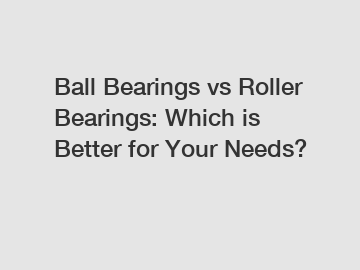Ball Bearings vs Roller Bearings: Which is Better for Your Needs?
Ball Bearings vs Roller Bearings: Which is Better for Your Needs?
When it comes to choosing the right type of bearings for your machinery or equipment, the choice often boils down to ball bearings or roller bearings. Both types have their own unique characteristics and advantages, so it's crucial to understand the differences between them in order to make an informed decision. In this article, we will compare ball bearings and roller bearings to help you determine which is better suited for your specific needs.
Ball Bearings.

Ball bearings are one of the most common types of bearings used in various applications, from automotive to industrial. They consist of a series of small balls that evenly distribute the load over a small surface area, allowing for smooth and efficient rotation. Ball bearings are known for their high levels of precision, low friction, and quiet operation, making them ideal for high-speed applications.
Advantages of Ball Bearings:
1. High precision and tolerance.
2. Low friction and smooth operation.
3. Quiet performance.
4. Suitable for high-speed applications.
While ball bearings offer numerous advantages, they may not be ideal for heavy-duty applications that require higher load capacities. In such cases, roller bearings may be a better option.
Roller Bearings.
Roller bearings, as the name suggests, use cylindrical rollers instead of balls to distribute the load. This design allows roller bearings to withstand higher radial and axial loads compared to ball bearings. Roller bearings are commonly used in heavy machinery, large equipment, and applications with high load requirements.
Advantages of Roller Bearings:
1. Higher load capacity.
2. Ideal for heavy-duty applications.
3. Can withstand radial and axial loads.
4. Greater contact surface area for load distribution.
While roller bearings excel in terms of load capacity, they may not offer the same level of precision and efficiency as ball bearings. Roller bearings may also produce more noise and friction compared to ball bearings.
Comparison.
When deciding between ball bearings and roller bearings, it's essential to consider the specific requirements of your application. If you need high-speed performance, precision, and low friction, ball bearings may be the better choice. On the other hand, if you require higher load capacities and durability for heavy-duty applications, roller bearings are likely the more suitable option.
Ultimately, the decision between ball bearings and roller bearings will depend on factors such as load requirements, speed, precision, noise levels, and overall performance expectations. It's always best to consult with a bearing specialist to determine the most appropriate type of bearing for your specific needs.
Conclusion.
In conclusion, both ball bearings and roller bearings have their own set of advantages and disadvantages, making each suitable for different types of applications. Whether you choose ball bearings or roller bearings will depend on the specific requirements of your machinery or equipment. By understanding the differences between these two types of bearings, you can make an informed decision that maximizes the performance and longevity of your equipment.
Contact Us.
If you have any questions or need assistance in choosing the right bearings for your needs, please feel free to contact us. Our team of experts is here to help you find the best solution for your application.
Contact us to discuss your requirements of 62tb0629b29, release bearing function, tensioner bearing factory. Our experienced sales team can help you identify the options that best suit your needs.
117
0
0


Comments
All Comments (0)